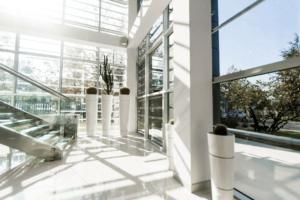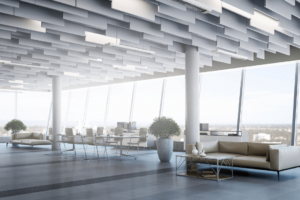
When it comes to commercial lighting applications, it is easy to completely overlook daylighting and rely only on artificial light. While daylight is not a possibility for all commercial lighting applications—warehouses, for example, will not be able to implement daylighting principles into their lighting control systems— for spaces like office buildings and retail stores, daylighting is a powerful lighting concept that can enhance both visitor and employee experiences. Additionally, relying on natural light helps businesses conserve energy and save on monthly energy costs.
The effects of daylight on building inhabitants are overwhelmingly positive. With sunlight being closely linked to human health and our natural circadian rhythm, many commercial spaces are searching for ways to incorporate daylighting into their lighting architecture. That’s why we’re exploring what daylighting is and the benefits of supplementing your commercial lighting controls with daylight sensors. Let’s get started by defining daylighting, and then we’ll take a closer look at all of the ways companies can benefit from some added sunlight.
What is Daylighting and How Does it Work With Commercial Lighting Controls?

By installing sensors in your space, you can harness the power of the sun and decrease monthly energy usage. Buildings with large windows are perfect for adaptive lighting controls.
Unlike most commercial lighting topics, daylighting is easy to explain and imagine. Daylighting refers to the practice of incorporating natural sunlight into interior lighting design. This phrase is used outside of commercial lighting controls to describe any kind of supplementary lighting including skylights or reflective surfaces designed to direct sunlight indoors.
When speaking about lighting applications, daylighting refers to the adjusting of artificial light to favor sunlight. In practice, this means that interior lights will dim as sunlight shines in the space, and will intensify as the outdoor light weakens. But, how can building controls respond to the sun in real-time? The answer is sensors!
Lighting sensors are the key to daylighting for large commercial applications. Using sensors installed throughout the interior of the building, your building control system will be able to monitor natural light and make necessary adjustments in real-time.
Natural light changes all the time depending on the time of day and the weather conditions. As these changes occur, the sensors will pick up on how much light is shining in the building and communicate with individual fixtures to compliment the outdoor lighting at all times of the day and in all weather conditions. By adjusting the setting in your building management system, you can designate how much light is required for different buildings or different parts of a building to ensure that no areas are ever overlit or underlit. Overall, the consistent monitoring and adjustment of lighting levels based on natural daylight are what define commercial daylighting.
Now that we’ve taken a bit of time to define daylighting for commercial spaces, let’s discuss how your company can benefit from using sensors to monitor and control interior lighting levels.
Use Daylighting to Cut Monthly Energy Costs

By supplementing natural lighting rather than overlighting, businesses will save money and conserve energy while improving light quality. Daylighting ensures that lights stay as dim as possible to reduce energy consumption.
For all businesses, the bottom line is the most important indicator for moving improvement projects forward. While there are very real human benefits to installing sensors as a part of your commercial lighting controls, the benefit that is most important for building managers is the monetary savings. Too often large commercial spaces overpay for their lighting because they are not taking advantage of natural light. Without daylighting, businesses end up overlighting areas of the building that can be sufficiently lit naturally. Also, without sensors lighting levels remain constant throughout the day in most cases, which contributes to energy wasted. On a cloudy day—for example—the sun will go in and out of the clouds several times. Throughout the day, your lighting fixtures will respond to information from the sensors to keep lights off or as dim as possible throughout the day. As the sun changes, so will your interior lighting which will save you money on operating costs. Just by implementing lighting sensors for daylighting, companies can save up to 25% on their monthly lighting costs.
Create Healthier Lighting Landscapes for Employees

Since we spend so much of our time indoors, it is important that interior lighting is as natural as possible. Intuitive lighting reduces eye strain.
Commercial spaces, like offices or healthcare facilities, are often associated with harsh, exhausting lighting. These negative associations are a product of constant, and often fluorescent lighting. As studies are showing that this outdated style of lighting contributes to excess fatigue and eye strain, managers are searching for ways to minimize artificial lighting. That’s where daylighting principles can help. Using sensors placed around the building, lighting fixtures can adapt to make sure that there is never an excessive amount of artificial light. It is also important to note that for the sensors to transmit information to the light, you need to be using LED light fixtures. LEDs are far more versatile than other lighting methods and can produce a wide range of tones and hues to perfectly adapt to the light coming from the sun. LED light combined with the adaptive lighting capabilities of the sensors helps create a much healthier lighting landscape for anyone who enters the building.
There are also settings you can change to ensure that the lights can mimic the type of lighting that works with our circadian rhythm. For example, lights produce brighter tones earlier in the day and gradually progress to warmer tones as the sun begins to set. By making these small adjustments, employees report less eye strain and overall stress in the workplace.
Take Steps Toward Sustainable Lighting

By combining daylighting sensors with LED lights, businesses can reduce their electricity consumption and carbon footprint. New office buildings are prioritizing sustainability.
In the last few decades, there has been an increased level of awareness about how our energy consumption affects the environment. With major looming issues like climate change and deforestation, companies are searching for ways to help decrease harmful emissions and the use of fossil fuels. By incorporating lighting controls for daylighting and LEDs, businesses can decrease their emissions, and in some cases even take advantage of incentives set forth by the government.
Recently, many companies have set forth ambitious sustainability goals. If you are working with a company that is searching for ways to reduce their emissions, lighting controls and daylighting is a great place to start. As we previously mentioned, businesses can save up to 25% on their lighting costs just by implementing adaptive sensors as a form of lighting control. That not only represents monthly savings, but also monthly energy usage. Since the majority of the electric energy in the U.S. comes from burning coal, your adaptive lighting initiative will help your business reduce carbon emissions and reach sustainability goals.
Improve Interior Aesthetic

Daylighting is not only practical, it can also improve the overall look of a commercial space. Adaptive lighting design improves interior aesthetics.
First impressions are important! Depending on your industry, you may want to show off your commercial space to prospective clients or employees. If the lighting in your space is lacking—or worse—depressing, you may be missing out on important opportunities for your company.
To make sure that your building interior is looking as appealing as possible, daylighting is absolutely necessary. Not only is adaptive lighting easier on the eyes than a constant light output, but it also makes your space look friendlier and larger. In general, the more natural daylight that you can incorporate into your space, the better.
To implement daylighting for aesthetic purposes, you may want to hire a lighting designer for some advice on how to optimize your interior lighting for the best results. If you are in the process of replacing your outdated lighting in favor of LEDs, a lighting designer can help you work on the placement and positioning of each fixture so you can create the most appealing interior lighting profile possible.
Overall, the more natural daylight you can include in your commercial space, the better. Incorporating natural lighting is necessary for energy saving, employee health, sustainability, and aesthetic appeal. By optimizing your lighting controls with sensors and replacing your lighting fixtures with LEDs, you can begin to reap all of the benefits of daylighting. Very often, these lighting solutions are relatively inexpensive and make a huge difference. For example, many lighting sensors are inexpensive and battery-powered, which means that they do not require professional installation. So, what are you waiting for? Better and more intuitive lighting solutions are available and will drastically improve how your company approaches interior lighting.






